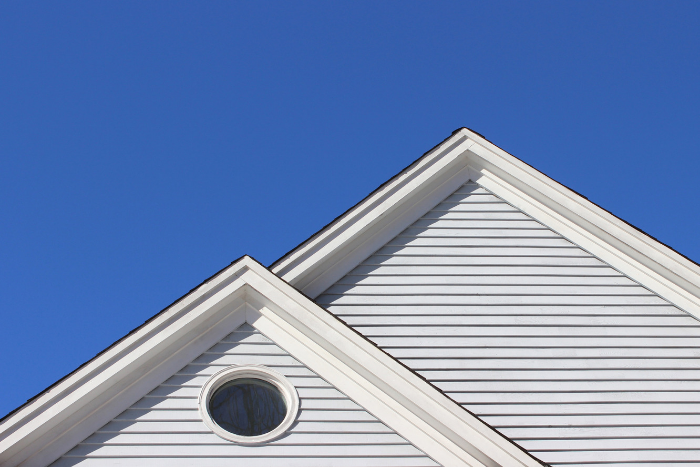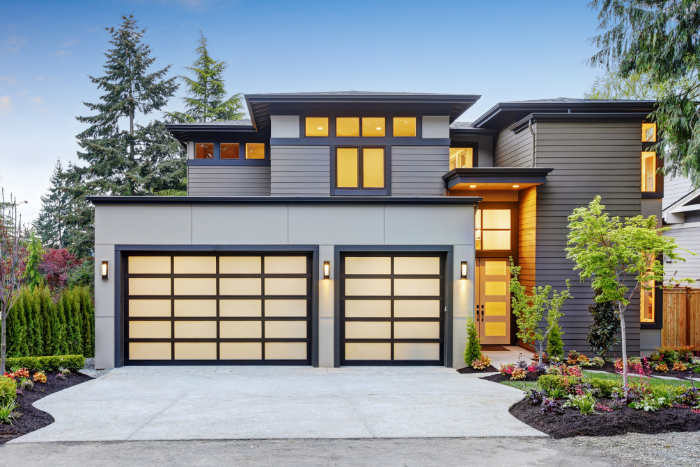ROOF DESIGN TYPES
Roofs are never a one shape or size fits all kind of deal, even though many people assume they are. Most homeowners don’t think much about their roofs until they need to repair or replace them, and they assume that they should only consider the roofing materials. In order to give your roof and home more personality, you should consider how the peaks and valleys merge together to affect the overall look and function of your roof. There are many different roof design types, all that come with unique purposes and some are more suitable for different weather conditions and building styles. Here are just a few of the more popular modern roof design types.
GABLE ROOF
Gable roofs, also known as pitched or peaked roofs, are one of the most popular roof types in the United States. Gable roofs have a triangular shape and are what many people envision when they think of a traditional roof design. There are various types of gable roofs such as a side gable, crossed gable, front gable, or a dutch gable roof. Gable roofs can be designed with almost any type of roof pitch from a low slope ranch style to a steep a-frame.
Gable roofs have a simple design, which makes them easy to build and cheaper than other, more complex roof design types. Roofing contractors typically love gable roofs because they only involve covering two flat surfaces without hips or valleys that need extra seams and materials. They can be covered using almost any type of roofing material including asphalt shingles, cedar shakes, metal, clay, or concrete tiles.
Pros: Due to their triangular pitch, gable roofs allow for additional floor space for a loft or attic, or you can have beautiful vaulted ceilings to add space and a modern feel to the inside of your home. Gable roofs easily shed water, which makes them great for high rain or snow areas.
Cons: Gable roofs are not ideal for areas with hurricanes or high winds because the roof can potentially collapse or materials can peel away. If gable roofs have a big overhang, high winds can even cause the roof to detach completely from the walls.
HIP ROOF
Hip roofs have slopes on all four sides that are equal length and slope downwards towards the walls. Sometimes the four sides meet at a point, but they don’t always. Hip proofs provide shade and cover on all sides of a home, unlike gable roofs. There are various types of hip roofs such as simple hip, pyramid hip, cross hipped, and half hipped.
Similar to gable roofs, hip roofs can be made with just about any roofing material such as shingles, metal, or various tiles. Proper waterproofing is incredibly important with all roofs, but especially hip roofs because of the valleys where the roof angles meet.
Pros: Hip roofs are incredibly stable, sturdy, and durable which makes them excellent for high rain, snow, and wind areas. They also allow for extra space for a beautiful dormer window or a small room to lookout from.
Cons: Due to their complex design, hip roofs require more roofing materials, therefore they are typically more expensive to build. If a hip roof has a dormer window, additional seams are needed which makes it more likely to have water leaks form in the valleys if a roofing system is not properly installed.
FLAT ROOF
Flat roofs are simple in form and function and add a modern look to a home due to their clean lines that resemble the horizontal line often seen in nature. Despite the sound of their name, flat roofs actually have a slight slope to allow water to run-off and drain. Flat roofs do not take up much space due to their slight pitch and can be used to provide additional sun protection for your outdoor living space.
It is very important to use roofing materials that are continuous and without seams when installing flat roofs to ensure they are completely waterproof. The most common roofing materials used on flat roofs are gravel, roll roofing, metal sheets, PVC, TPO, and rubber.
Pros: Flat roofs look great on modern or mid-century style homes due to their clean lines. They are also common on commercial buildings or home additions such as a sunroom. Flat roofs are great for adding more living space by incorporating a patio, deck, rooftop garden, or green roof on top of your home.
Cons: Even though flat roofs have a slight slope for water drainage, they are more susceptible to water leakage, therefore flat roofs are not ideal for high rain or snow areas.
SHED ROOF
Shed roofs, sometimes referred to as skillion roofs, are different from most roofs because they are only pitched in one direction, therefore they only have one slope. Traditionally, shed roofs were used for home additions, sheds and porches, but they are becoming increasingly popular on homes due to their interesting modern look.
Framing and installing shed roofs is pretty simple and similar to flat roofs because they use fewer building materials than other roof types. Due to their steep incline, you do not need rubber skins and roofing membranes. Shed roofs can be made using a standing seam instead of tiles or shingles.
Pros: Since shed roofs drain water on one side, it is easy to collect and store rainwater to reuse and live more sustainably. Due to the higher slope on one side, shed roofs can create a nice aesthetic appeal, while also being ideal for high rain and snow regions.
Cons: You lose attic space with shed roofs and due to the steep incline, you can end up with low ceilings on one side of your home. Shed roofs are not ideal for high wind areas.
These are just four of the 30+ different roof design types available. It is common for people to feel overwhelmed when considering the many different roof shapes, designs and materials, which is why we recommend that you consult with a trusted roofing contractor to help guide you through this process and make the best decision for your home.
Here at Resilient Roofing, we are dedicated to excellence in quality materials, professional workmanship and customer service. We are licensed, bonded, and have multiple layers of insurance while specializing in new roof installation, repair, and maintenance. If you are considering a new roof or would like to have us come out for a free consultation and estimate, don’t hesitate to reach out!




